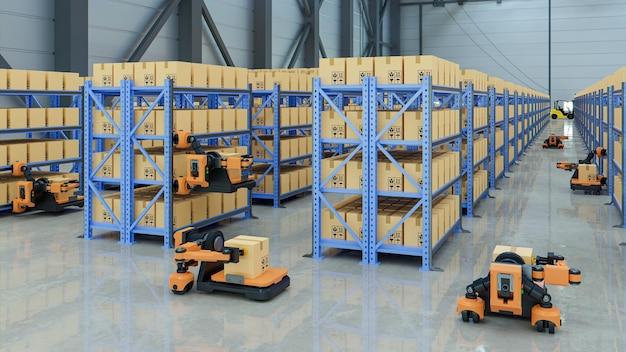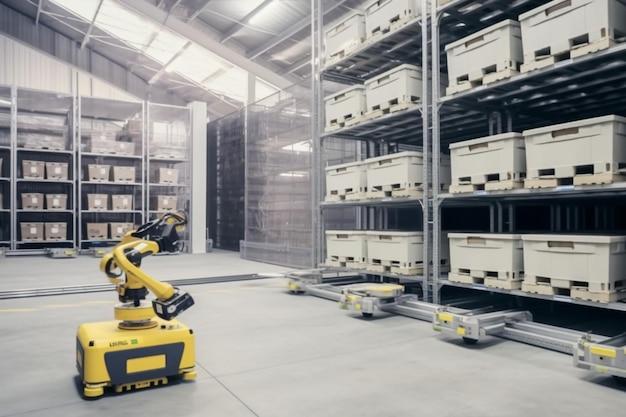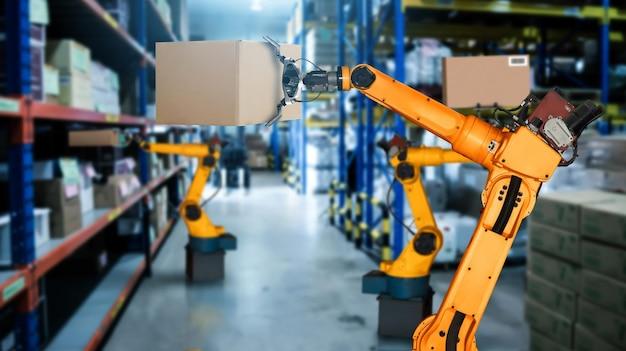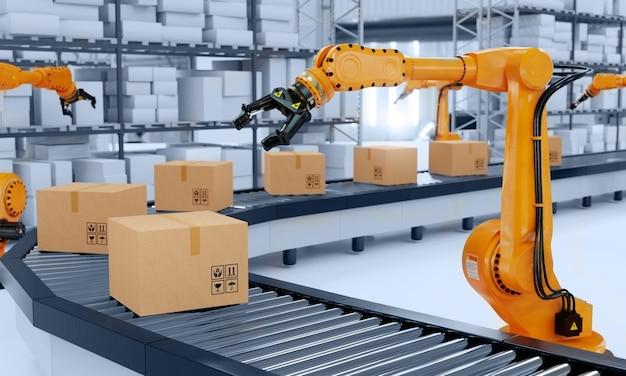In today’s world, technology has rapidly taken over the business world, and the warehouse industry is no exception. Automated picking systems have completely transformed the way warehouses operate, streamlining the picking and packing process. With the introduction of automated picking robots and pick and pack automation, warehouses have become more efficient and cost-effective.
The use of warehouse picking technology has minimized the need for human intervention, reducing the risk of errors and increasing productivity. Automated warehouse picking involves a combination of computerized systems and machinery to pick and pack products, resulting in a faster and smoother operation.
The types of automated picking systems used in the industry vary, depending on the size and needs of the warehouse. These range from automated storage and retrieval system (ASRS) to autonomous mobile robots (AMRs) and automated guided vehicles (AGVs).
But, what is automated warehouse picking, and why is it essential in the 21st century? In this blog post, we’ll delve deeper into the world of automated picking systems, exploring the benefits of warehouse automation and the three most commonly used picking systems in warehousing. So, sit back and enjoy the ride as we explore the future of the warehouse industry.
Automated Picking Systems for Warehouses
Automation in the warehouse is becoming increasingly crucial in the fast-paced world of e-commerce and logistics. One of the most significant advancements in this regard has been the development of automated picking systems for warehouses. These systems have transformed the warehouse management process, enhancing not only efficiency but also accuracy.
What is an Automated Picking System
An automated picking system is a system that uses robots and software to manage the process of picking and delivering products to their final destination. These systems use advanced sensors and algorithms to identify and extract products from warehouse shelves, totes, and bins, then transport them to the designated delivery point without human intervention.
How do Automated Picking Systems Work
Automated picking systems operate using a combination of robots, conveyors, sensors, and warehouse management software. These systems use sensors and cameras to identify product locations and track inventory levels in real-time. When an order comes in, the robot will analyze the order list, determine the best route, and transport the product to the delivery point, all within a matter of minutes.
Advantages of Automated Picking Systems
The adoption of automated picking systems has several advantages for warehouses, including:
- Increased accuracy
- Enhanced efficiency
- Improved order fulfillment times
- Reduced product damage
- Reduced labor costs
Potential Disadvantages of Automated Picking Systems
While automated picking systems offer several advantages, they also have a few potential downsides. These include:
- High upfront investment costs
- Complex integration and implementation processes
- Issues with maintenance and repair
Automated picking systems have revolutionized the warehouse industry, offering improved efficiency, accuracy, and reduced costs. These systems are the future of warehouse management and will undoubtedly continue to evolve to meet the fast-changing demands of the e-commerce and logistics industries.
Automated Warehouse: Revolutionizing the Way We Store Inventory
Automated warehouses are becoming increasingly popular for good reasons. The latest trend in the warehousing industry is automation. The idea of an automated warehouse is to make storage and retrieval of inventory easier, efficient, and cost-effective. In this section, we will discuss the basic concept of automated warehouse and how it is transforming the way we store inventory.
What is an Automated Warehouse
An automated warehouse is a storage facility where all activities from receiving to dispatching are controlled and managed by computer systems. These warehouses can store and move goods automatically, using high-tech machinery such as robots, conveyors, automated storage and retrieval systems (ASRS), and automated guided vehicles (AGV). The entire operation is operated by a warehouse management system (WMS) that collects, manages and presents information about inventory levels, order processing, and shipment.
Advantages of an Automated Warehouse
Automated warehouse systems are beneficial to companies in different ways. One of the biggest advantages is that they reduce labor costs and increase safety significantly. The machines are highly efficient, and they can move products without breaks, which decreases downtime. Moreover, an automated warehouse can increase storage capacity by using vertical spaces more effectively. This ability to store and retrieve products quickly and efficiently has helped companies to grow their businesses while reducing their costs.
Applications of an Automated Warehouse
Automated warehouses are used in various industries such as retail, e-commerce, food and beverage, and automotive, among others. In retail, an automated warehouse can help handling large orders by reducing the time between processing and shipping. In e-commerce, they can automate the picking and packing process, reducing errors, and increasing accuracy and speed. In the food and beverage industry, automated warehouses can help store products safely and efficiently, which is essential, especially for perishable items. In automotive, automated warehouses can increase efficiency and reduce mistakes in handling and tracking high-value parts.
In conclusion, automated warehouses are revolutionizing the way we store inventory. With the increasing demands for accuracy and efficiency, companies are turning to automated warehouses to streamline their storage and retrieval processes. Automated warehouses not only reduce the costs but also increase safety and productivity. They are highly versatile and can be applied to different industries. Therefore, it is essential for companies to consider implementing automated warehouses in their operations to stay competitive and grow their businesses.
Automated Picking Robots
Automated picking robots are becoming increasingly popular in warehouses worldwide. These robots have revolutionized the way products are picked and moved in the warehousing industry. In this section, we will take a closer look at automated picking robots, their benefits, and how they work.
Benefits of Automated Picking Robots
Automated picking robots offer several advantages over traditional picking methods. One of the significant benefits is speed. These robots can quickly move and pick products, which helps to reduce the time it takes to fulfill orders. Additionally, they operate continuously, which means that they can pick products at all hours without any breaks.
Another significant advantage of using automated picking robots is improved accuracy. These robots operate using algorithms that provide precise measurements and coordinates, which reduces the likelihood of picking errors. This not only saves time and money but also reduces the risk of customer dissatisfaction.
How Automated Picking Robots Work
Automated picking robots operate using advanced technology. Most robots have a conveyor belt that moves products to a designated area where the robot’s arm picks the product. The robot uses sensors to detect the product’s position, and then the arm moves precisely to pick up the product.
Once the robot has picked the product, it moves it to the appropriate location for either storage or shipping. The process is entirely automated, which means that the robot can repeat it continuously without human intervention.
Automated picking robots are an excellent addition to any warehouse. They offer benefits such as speed and accuracy and are an excellent investment for any company looking to improve their warehouse operations. With their advanced technology and ability to operate 24/7, they are quickly becoming a must-have for companies worldwide.
Pick and Pack Automation
One of the most critical components of any warehouse operation is pick and pack. This process involves selecting ordered items from the warehouse shelves (picking), packing them for shipment, and labeling them accurately. In conventional warehouse setups, this process is manual, and it can be time-consuming, inefficient, error-prone, and costly. That’s where Automated Picking Systems come in.
What is Pick and Pack Automation
Pick and pack automation is the use of technology to reduce or eliminate the need for manual intervention in the order processing cycle. Automated Picking Systems can help minimize or eliminate errors in picking and packing, reduce costs, and enhance overall efficiency.
Advantages of Pick and Pack Automation
Minimized Errors
One of the most significant advantages of pick and pack automation is the elimination of errors that are likely to occur in manual operations. Automated systems can detect and correct errors, detect or prevent duplicate orders, and mismatched orders – leading to higher customer satisfaction.
Increased Efficiency
Pick and pack automation helps minimize or eliminate inefficiencies from the order processing cycle, including the elimination of unnecessary movements, fewer handling errors, and faster processing times. This makes it possible to handle more orders in less time, leading to higher productivity.
Reduced Labor Costs
Pick and pack automation can help reduce labor costs by automating repetitive and labor-intensive tasks. Fewer employees will need to be employed, and the ones remaining in the warehouse can focus on more skilled tasks like handling exceptions or dealing with priority orders.
In conclusion, pick and pack automation using Automated Picking Systems can significantly improve the efficiency and productivity of warehouses. By minimizing errors, increasing efficiency, and reducing labor costs, these systems offer a valuable solution to a longstanding issue that plagues most warehouses.
Warehouse Picking Technology
Warehouse picking technology has revolutionized the way products are picked, packed, and delivered to customers. This technology has helped many businesses to streamline their logistics processes and speed up product delivery. In this section, we will take a closer look at some of the latest warehouse picking technology innovations.
Voice-Activated Picking Technology
Voice-activated picking technology is a cutting-edge technology that allows warehouse workers to communicate with the warehouse management system through voice commands. This technology is particularly useful in warehouse environments where workers need both hands to handle products.
With voice-activated picking technology, workers can call out the item they are looking for, and the system will direct them to its precise location in the warehouse. This technology has been shown to increase accuracy and reduce picking time, leading to faster and more efficient order fulfillment.
Barcode and RFID Technology
Barcode and RFID technology are popular warehouse picking technologies that have been around for some time. Barcodes are used to tag products with unique identifying numbers that can be scanned by handheld devices or fixed scanners. RFID technology, on the other hand, uses radio waves to identify and track products.
Barcodes and RFID technology help to reduce picking errors and increase efficiency by providing real-time inventory information. They allow warehouse workers to quickly identify the location of products and verify that they have picked the correct item before moving on to the next order.
Automated Picking Systems
Automated picking systems are a game-changer in warehouse operations. These systems use robots or drones to retrieve products from storage locations and deliver them to the packing stations. Automated picking systems have been shown to dramatically reduce the time it takes to pick and pack orders, leading to faster and more efficient order fulfillment.
With automated picking systems, businesses can have their orders picked and packed 24/7, ensuring that their customers receive their orders on time. These systems also help to reduce labor costs, as they require fewer workers to operate.
Warehouse picking technology has come a long way in recent years, and businesses that embrace these technologies can enjoy lots of benefits, including faster order fulfillment, higher accuracy, and reduced picking errors. Voice-activated picking technology, barcode and RFID technology, and automated picking systems are just a few examples of the latest technologies that can help businesses to streamline their operations and improve customer satisfaction.
Types of Automated Picking Systems
An automated picking system is an essential component of modern warehouse operations. It involves using technology to pick and transport products without human intervention. There are several types of automated picking systems that warehouse managers can employ to improve operational efficiency and productivity.
Automated Storage and Retrieval Systems (AS/RS)
Automated Storage and Retrieval Systems (AS/RS) are computer-controlled systems that manage inventory and automatically retrieve items when needed. AS/RS utilizes robots and conveyors to store and retrieve items in the warehouse. The system is helpful in reducing labor costs, minimizing the risk of errors, and increasing storage capacity.
Goods-to-Person Systems
This picking system involves delivering the products to the worker instead of the worker going to retrieve them. Robotics and automated guided vehicles transport the products to the worker, who completes the order and sends them back to the system to prepare for the next order. Goods-to-Person systems are efficient in reducing the walking distance, enhancing the accuracy of item selection, and minimizing the order fulfillment time.
Person-to-Goods Systems
Person-to-Goods systems involve the worker physically going to the location of the product to pick and transport it to the order fulfillment area. This approach is ideal for warehouses that store larger items that cannot be transported by automated systems. Person-to-Goods systems are helpful in reducing the risk of errors, increasing product visibility, and accommodating multiple order configurations.
Automated Guided Vehicle (AGV) Systems
Automated Guided Vehicle (AGV) Systems use self-guided vehicles that transport products throughout the warehouse. The vehicles have sensors that help avoid collisions and navigate the warehouse. AGVs can operate in confined spaces and can handle heavy loads, which makes them ideal for large warehouses with heavy items.
Piece Picking Systems
Piece Picking Systems involve picking individual products to fulfill orders. The system is automated and utilizes robots and conveyors to facilitate product selection and transport. Piece Picking Systems are helpful in reducing labor costs, minimizing the risk of errors, and increasing the speed of order fulfillment.
In conclusion, these automated picking systems can revolutionize a warehouse’s operations by streamlining processes, increasing efficiency, reducing labor costs, and improving overall warehouse management. Warehouse managers should carefully consider the needs of their warehouse before choosing the most suitable automated picking system.
What is Automated Warehouse Picking
In the world of warehousing, technology is continually changing, and with advancement comes efficiency. The automated picking system is a vital technological advancement for ensuring faster, more efficient, and accurate order fulfillment in warehouse operations.
Definition of Automated Warehouse Picking
Automated Warehouse Picking refers to the computer-controlled technology that oversees the storage, retrieval, and transportation of inventory in a warehouse. The system operates with minimal or no human intervention and uses robotic systems, conveyor belts, or automated storage systems to pick items for order fulfillment.
How Does Automated Warehouse Picking System Work
Automated Warehouse Picking Systems use various technologies to operate and include different stages for storing, retrieving, and transporting.
Storage
In an automated warehouse picking system, incoming inventory is first stored via an automated system, such as AS/RS (Automated Storage and Retrieval System), which stores and retrieves products from a vertical storage system.
Retrieval
When an order is made, the inventory is retrieved from the storage system using automated robots, cranes, or other specialized equipment.
Transportation
Once the item is retrieved, it is transported to a fulfillment center, where further automatic processes occur, such as sorting, labeling, and packing.
Benefits of Automated Warehouse Picking
Automated warehouse picking offers a myriad of benefits for warehouse operations, including:
- Increased efficiency, accuracy, and speed
- Improved safety, reducing the risk of accidents in the workplace
- Better space utilization
- Reduced labor costs and the need for manual labor
Automated warehouse picking systems are revolutionizing the world of warehousing. The intelligent combination of robotic technology and computer software makes the system highly efficient, reliable, and safe for order fulfillment. It’s an ideal solution for businesses that want to increase productivity, reduce errors, and better optimize their warehouse space.
Automated Storage and Retrieval System
An automated storage and retrieval system (AS/RS) is a type of material handling system that handles, stores, and retrieves materials with little or no human intervention. It is commonly used in distribution centers, manufacturing plants, and warehouses to automate the process of storing and retrieving products.
How AS/RS Works
An AS/RS uses computer-controlled systems for storing and retrieving products from designated storage locations. The system works by using a set of sensors, conveyors, and robotic arms to move products to and from the storage aisles. The products are usually stored in pallets or totes and are retrieved by the AS/RS system as needed.
Benefits of AS/RS
One of the main benefits of AS/RS is the reduction in labor costs and errors. With AS/RS, the need for manual labor is significantly reduced, which translates to lower costs and increased efficiency. The system is also highly accurate and can retrieve products quickly and efficiently, reducing the chances of errors and improving customer satisfaction.
Another benefit of AS/RS is the increased capacity for storage. AS/RS systems can store products in high-density storage areas, such as elevated racks or narrow aisles, maximizing warehouse space and increasing the storage capacity.
Types of AS/RS
There are different types of AS/RS systems, including unit load, mini-load, and shuttle systems. Unit load systems are used for storing and retrieving pallets, while mini-load systems are used for storing and retrieving smaller items like boxes or totes. Shuttle systems, on the other hand, use robotic shuttles to move products within the storage aisles.
An automated storage and retrieval system is an essential component of any modern warehouse or distribution center. It provides increased storage capacity, accuracy, and efficiency, while also reducing labor costs and errors. AS/RS systems come in different types and can be customized to fit the specific needs of different businesses. With the benefits that come with implementing an AS/RS, it is no wonder that more and more businesses are making the switch to automated warehouse systems.
Which are the 3 most used picking systems in warehousing
When it comes to optimizing the productivity of a warehouse, automating the picking process is a great place to start. Automated picking systems have been on the rise in recent years, and it’s not hard to see why – they reduce labor costs, minimize the risk of human error, and maximize efficiency. But which picking systems are the most commonly used? Here are the top three:
1. Automated Storage and Retrieval Systems (AS/RS)
AS/RS systems are among the most commonly used picking systems in warehouses. They are essentially giant, three-dimensional structures that house items in a grid-like formation. When an item needs to be retrieved, a robotic crane locates it and brings it to a retrieval point where an operator can pick it up and move it to its next destination. This system is particularly useful for high-density storage and makes it possible to store a large number of items in a small amount of space.
2. Goods-to-Person Systems (GTP)
In a Goods-to-Person (GTP) system, the items being picked are brought to the operator rather than the other way around. This is done by using automated guided vehicles (AGVs) or conveyors to transport items to a pick station. GTP systems allow for faster pick and cycle times and more efficient use of space since there is no need for a separate picking area. This system is particularly useful for smaller items and e-commerce order fulfillment.
3. Pick-to-Light Systems (PTL)
Pick-to-Light (PTL) systems use a series of lights and displays to direct pickers to the location of items they need to pick. Each item has its own light, and each location has a display that shows the quantity of items to be picked. The picker goes to the location, picks the items, and confirms the pick on the display. This system is particularly helpful for high-volume, single-item orders since it eliminates the need for searching for items in a complex storage system.
In conclusion, there are many picking systems available in the market. However, AS/RS, GTP, and PTL are the three most commonly used automated systems in the warehousing industry. Each system has its unique features and benefits, and choosing the right one for your warehouse depends on your specific needs. With effective implementation, these automated picking systems can streamline the picking process, minimize the risk of errors, and maximize efficiency.
What is Warehouse Automation and What Are the Benefits of an Automated Warehouse
Automation in the warehouse is the adoption of computerized equipment and technology that helps to manage and optimize warehouse operations. This technology is used to improve the efficiency and accuracy of various warehouse activities, such as inventory management, order fulfillment, and transportation.
Benefits of Automated Warehouses
There are several benefits that businesses can enjoy with automated warehouses. Here are some of the most significant advantages:
1. Improved Accuracy
Automated warehouses minimize human error that often occurs during manual operations. Automated picking systems are designed to pick items with precision and speed, reducing the likelihood of mistakes.
2. Increased Efficiency
Automation in the warehouse makes it easier to manage and optimize different warehouse operations. Automated systems can process orders faster, allowing businesses to handle an increased volume of orders or products.
3. Better Space Utilization
Automated systems can maximize the utilization of warehouse space by optimizing storage and delivery. This means that more products can be stored in the same space, allowing businesses to increase their sales while using the same amount of space.
4. Reduced Labor Costs
Automating warehouse operations can reduce labor costs, as fewer workers are needed to complete the same tasks. This also helps to minimize the likelihood of workplace injuries and illnesses that can result from hazardous manual activities.
5. Increased Customer Satisfaction
With automated warehouse systems, businesses can handle orders faster and more accurately. This results in faster delivery times, improved order accuracy, and better customer service.
In summary, warehouse automation offers various benefits that help businesses to manage their operations more effectively. With improved accuracy, increased efficiency, better space utilization, reduced labor costs, and increased customer satisfaction, businesses can automate their warehouses to achieve a competitive edge in their industry.



